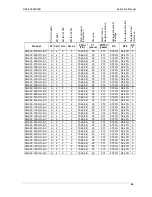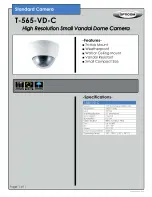
SG2 EXTENDED
Instruction Manual
56
15. GLOSSARY
ACTIVE OPTOELECTRONIC PROTECTIVE DEVICE (AOPD):
its detection function is achieved thanks
to the use of optoelectronic receivers and emitters detecting the optical beams interruptions inside the
device caused by an opaque object present inside the specified detecting area.
An active optoelectronic protective device (AOPD) can operate both in emitter-receiver mode and in
retro-reflective light curtains.
BLOCK CONDITION (=BREAK):
status of the light curtain taking place when a suitably-sized opaque
object (see DETECTING CAPACITY) interrupts one or several light curtain beams.
Under these conditions, OSSD1 and OSS2 light curtain outputs are simultaneously switched OFF within
the device response time.
CONTROLLED MACHINE:
machine having the potentially-dangerous points protected by the light
curtain or by another safety system.
CROSSING HAZARD:
situation under which an operator crossing the area controlled by the safety
device and this latter stops and keeps the machine stopped until the hazard is eliminated, and then
enters the dangerous area. Now the safety device could not be able to prevent or avoid an unexpected
restart of the machine with the operator still present inside the dangerous area.
EMITTER:
unit emitting infrared beams, consisting of a set of optically-synchronised LEDs. The emitting
unit, combined with the receiving unit (installed in the opposite position), generates an optical “curtain”,
i.e. the detecting area.
DANGEROUS AREA:
area representing an immediate or imminent physical hazard for the operator
working inside it or who could get in contact with it.
DETECTING CAPACITY (= RESOLUTION):
limit of the parameter of the sensor function specified by
the supplier, that will enable the electrosensitive protective equipment (ESPE). In case of an active
optoelectronic protective device (AOPD), with resolution we mean the minimum dimension, which an
opaque object must have in order to interrupt at least one of the beams that constitute the sensitive
area.
ELECTROSENSITIVE PROTECTIVE EQUIPMENT (ESPE):
assembly of devices and/or components
working together to activate the protective disabling function or to detect the presence of something and
including at least: a sensor, command/control devices and output signal switching devices.
FINAL SWITCHING DEVICE (FSD):
part of the control system connected to machine safety and
breaking the circuit towards machine primary command element (MPCE) when the output signal
switching device (OSSD) reaches the inactive condition.
OUTPUT SIGNAL SWITCHING DEVICE (OSSD):
part of the electrosensitive protective equipment
(ESPE) connected to machine control system that, when the sensor is triggered during standard
operating mode, is switched to the inactive status.
MACHINE OPERATOR:
qualified person authorised for machine use.
MACHINE PRIMARY COMMAND ELEMENT (MPCE):
electrically-powered element having the direct
control of machine regular operation so as to be the last element, in order of time, to operate when the
machine has to be enabled or blocked.
MIN. INSTALLATION DISTANCE:
min. distance necessary to allow machine dangerous moving parts
to completely stop before the operator can reach the nearest dangerous point. This distance shall be
measured from the middle point of the detecting area to the nearest dangerous point. The factors
affecting min. installation distance value are: machine stop time, safety system overall response time,
barrier resolution.
N.O.:
normally opened
N.C.:
normally closed
OFF STATUS:
status when the output circuit is interrupted and does not allow current stream.
Содержание SG2 BASE Series
Страница 1: ...SG2 EXTENDED Instruction Manual...
Страница 3: ......
Страница 52: ...SG2 EXTENDED Instruction Manual 48 13 OUTFIT Rotating fixing bracket...
Страница 62: ...www automation datalogic com...


































